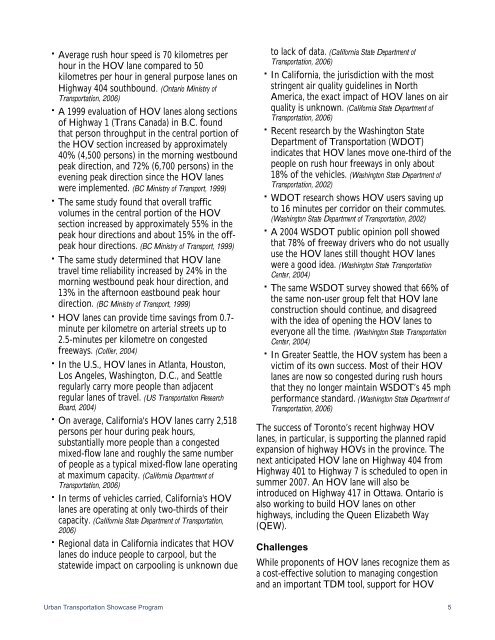High Occupancy Vehicle Lanes in Canada
High Occupancy Vehicle Lanes in Canada
High Occupancy Vehicle Lanes in Canada
Create successful ePaper yourself
Turn your PDF publications into a flip-book with our unique Google optimized e-Paper software.
• Average rush hour speed is 70 kilometres per<br />
hour <strong>in</strong> the HOV lane compared to 50<br />
kilometres per hour <strong>in</strong> general purpose lanes on<br />
<strong>High</strong>way 404 southbound. (Ontario M<strong>in</strong>istry of<br />
Transportation, 2006)<br />
• A 1999 evaluation of HOV lanes along sections<br />
of <strong>High</strong>way 1 (Trans <strong>Canada</strong>) <strong>in</strong> B.C. found<br />
that person throughput <strong>in</strong> the central portion of<br />
the HOV section <strong>in</strong>creased by approximately<br />
40% (4,500 persons) <strong>in</strong> the morn<strong>in</strong>g westbound<br />
peak direction, and 72% (6,700 persons) <strong>in</strong> the<br />
even<strong>in</strong>g peak direction s<strong>in</strong>ce the HOV lanes<br />
were implemented. (BC M<strong>in</strong>istry of Transport, 1999)<br />
• The same study found that overall traffic<br />
volumes <strong>in</strong> the central portion of the HOV<br />
section <strong>in</strong>creased by approximately 55% <strong>in</strong> the<br />
peak hour directions and about 15% <strong>in</strong> the offpeak<br />
hour directions. (BC M<strong>in</strong>istry of Transport, 1999)<br />
• The same study determ<strong>in</strong>ed that HOV lane<br />
travel time reliability <strong>in</strong>creased by 24% <strong>in</strong> the<br />
morn<strong>in</strong>g westbound peak hour direction, and<br />
13% <strong>in</strong> the afternoon eastbound peak hour<br />
direction. (BC M<strong>in</strong>istry of Transport, 1999)<br />
• HOV lanes can provide time sav<strong>in</strong>gs from 0.7-<br />
m<strong>in</strong>ute per kilometre on arterial streets up to<br />
2.5-m<strong>in</strong>utes per kilometre on congested<br />
freeways. (Collier, 2004)<br />
• In the U.S., HOV lanes <strong>in</strong> Atlanta, Houston,<br />
Los Angeles, Wash<strong>in</strong>gton, D.C., and Seattle<br />
regularly carry more people than adjacent<br />
regular lanes of travel. (US Transportation Research<br />
Board, 2004)<br />
• On average, California's HOV lanes carry 2,518<br />
persons per hour dur<strong>in</strong>g peak hours,<br />
substantially more people than a congested<br />
mixed-flow lane and roughly the same number<br />
of people as a typical mixed-flow lane operat<strong>in</strong>g<br />
at maximum capacity. (California Department of<br />
Transportation, 2006)<br />
• In terms of vehicles carried, California's HOV<br />
lanes are operat<strong>in</strong>g at only two-thirds of their<br />
capacity. (California State Department of Transportation,<br />
2006)<br />
• Regional data <strong>in</strong> California <strong>in</strong>dicates that HOV<br />
lanes do <strong>in</strong>duce people to carpool, but the<br />
statewide impact on carpool<strong>in</strong>g is unknown due<br />
to lack of data. (California State Department of<br />
Transportation, 2006)<br />
• In California, the jurisdiction with the most<br />
str<strong>in</strong>gent air quality guidel<strong>in</strong>es <strong>in</strong> North<br />
America, the exact impact of HOV lanes on air<br />
quality is unknown. (California State Department of<br />
Transportation, 2006)<br />
• Recent research by the Wash<strong>in</strong>gton State<br />
Department of Transportation (WDOT)<br />
<strong>in</strong>dicates that HOV lanes move one-third of the<br />
people on rush hour freeways <strong>in</strong> only about<br />
18% of the vehicles. (Wash<strong>in</strong>gton State Department of<br />
Transportation, 2002)<br />
• WDOT research shows HOV users sav<strong>in</strong>g up<br />
to 16 m<strong>in</strong>utes per corridor on their commutes.<br />
(Wash<strong>in</strong>gton State Department of Transportation, 2002)<br />
• A 2004 WSDOT public op<strong>in</strong>ion poll showed<br />
that 78% of freeway drivers who do not usually<br />
use the HOV lanes still thought HOV lanes<br />
were a good idea. (Wash<strong>in</strong>gton State Transportation<br />
Center, 2004)<br />
• The same WSDOT survey showed that 66% of<br />
the same non-user group felt that HOV lane<br />
construction should cont<strong>in</strong>ue, and disagreed<br />
with the idea of open<strong>in</strong>g the HOV lanes to<br />
everyone all the time. (Wash<strong>in</strong>gton State Transportation<br />
Center, 2004)<br />
• In Greater Seattle, the HOV system has been a<br />
victim of its own success. Most of their HOV<br />
lanes are now so congested dur<strong>in</strong>g rush hours<br />
that they no longer ma<strong>in</strong>ta<strong>in</strong> WSDOT’s 45 mph<br />
performance standard. (Wash<strong>in</strong>gton State Department of<br />
Transportation, 2006)<br />
The success of Toronto’s recent highway HOV<br />
lanes, <strong>in</strong> particular, is support<strong>in</strong>g the planned rapid<br />
expansion of highway HOVs <strong>in</strong> the prov<strong>in</strong>ce. The<br />
next anticipated HOV lane on <strong>High</strong>way 404 from<br />
<strong>High</strong>way 401 to <strong>High</strong>way 7 is scheduled to open <strong>in</strong><br />
summer 2007. An HOV lane will also be<br />
<strong>in</strong>troduced on <strong>High</strong>way 417 <strong>in</strong> Ottawa. Ontario is<br />
also work<strong>in</strong>g to build HOV lanes on other<br />
highways, <strong>in</strong>clud<strong>in</strong>g the Queen Elizabeth Way<br />
(QEW).<br />
Challenges<br />
While proponents of HOV lanes recognize them as<br />
a cost-effective solution to manag<strong>in</strong>g congestion<br />
and an important TDM tool, support for HOV<br />
Urban Transportation Showcase Program 5
















